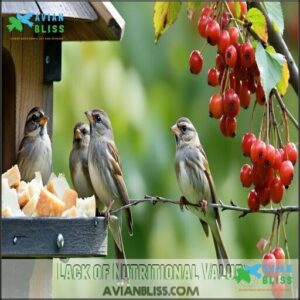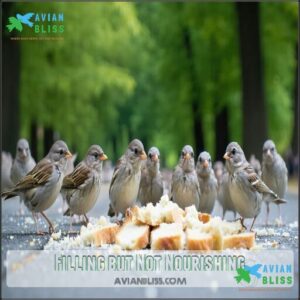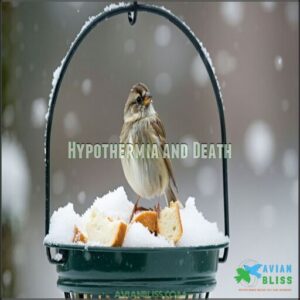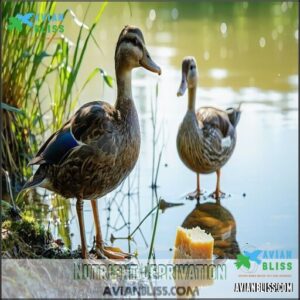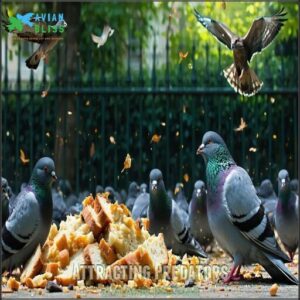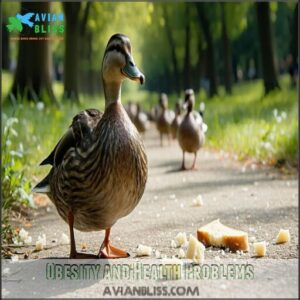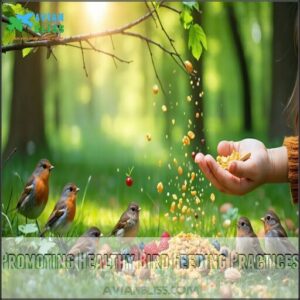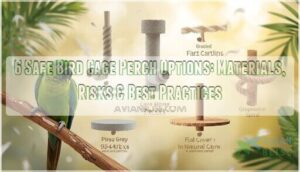This site is supported by our readers. We may earn a commission, at no cost to you, if you purchase through links.
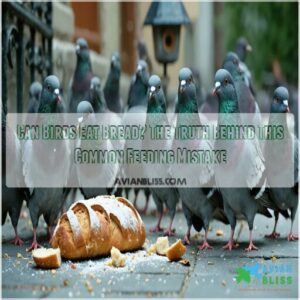
Bread fills their stomachs quickly, but it lacks the nutrients they need to stay healthy.
It’s like you eating nothing but chips—satisfying for a moment but leaves you malnourished.
Over time, too much bread can cause serious issues like malnutrition, deformities like “angel wing,” or even hypothermia in colder weather.
For waterfowl, it’s even worse, attracting predators and harming entire ecosystems.
Instead, offer seeds, fruits, or grains—they’re nutritious and safe.
Making smarter feeding choices also helps birds thrive and keeps nature balanced.
Curious about better options?
Table Of Contents
Key Takeaways
- Feeding bread to birds fills their stomachs but doesn’t provide the nutrients they need, leading to malnutrition and health problems like "angel wing."
- Moldy bread can cause respiratory infections, and leftover bread attracts pests and predators, harming bird habitats and ecosystems.
- Birds need natural foods like seeds, fruits, grains, and unsalted nuts to stay healthy and thrive, instead of bread’s empty calories.
- Offering bread disrupts birds’ natural foraging behavior, leaving them vulnerable to nutritional deficiencies and environmental threats.
Can Birds Eat Bread?
Despite good intentions, feeding birds bread is like offering candy for dinner—momentarily satisfying but nutritionally empty.
Feeding birds bread is like giving them junk food—it fills them up but leaves them starved for nutrients.
When birds eat bread, they’re filling their stomachs with carbs that provide little of the essential proteins, vitamins, and minerals they need to thrive.
Wild birds require specific nutrients for healthy feathers, strong bones, and proper development.
Bread lacks these critical components, potentially leading to waterfowl deformity in young birds and malnutrition in adults.
Additionally, moldy bread can cause serious respiratory infections in birds.
Uneaten bread attracts pests like rats and insects to feeding areas, creating unhealthy environments.
Robins, for example, benefit more from insects and fruits.
Bread fills their bellies but starves their bodies—skip it and offer real nutrition for healthy, happy birds.
Instead, consider bread alternatives like unsalted seeds, nuts, or fresh fruit pieces.
These natural foods better match birds’ nutritional needs without the harmful effects of bread for birds nutrition.
Harmful Effects of Feeding Bread to Birds
You’re harming birds when you feed them bread, as it fills their stomachs without providing essential nutrients they need to survive.
When birds consume bread regularly, they can develop serious health problems like angel wing syndrome, which permanently damages their flight capabilities, leading to a condition that can be described as a permanent harm to their well-being due to serious health problems.
Lack of Nutritional Value
Many birds are harmed by bread’s serious nutritional shortcomings. When you feed birds bread, you’re offering empty calories that lack essential nutrients they need to thrive.
- Bread contains virtually no protein, which birds require for feather growth and muscle development
- Vitamin deficiencies result from bread-heavy diets, weakening immune systems
- Mineral imbalance occurs when birds fill up on bread instead of natural foods
- The absence of healthy fats in bread affects birds’ energy levels and cold resistance
Even whole grain varieties provide limited benefits compared to birds’ natural diet requirements.
Filling but Not Nourishing
Bread fills birds up quickly while providing almost no benefits for their health.
When you toss bread at birds, you’re disrupting their natural foraging patterns and creating a false sense of fullness.
Feeding birds bread disrupts natural foraging, leaving their stomachs full but their bodies starved of crucial nutrients.
Birds are susceptible to key nutrient deficiencies, which bread consumption exacerbates.
| Nutritional Element | Bread Effect | Impact on Birds |
|---|---|---|
| Calories | Empty calories | Energy without nutrients |
| Digestive System | Quick filling | Skips nutritious foods |
| Behavior | Encourages begging | Alters natural diets |
Birds that regularly consume bread develop altered diets, focusing on these empty calories rather than seeking out nutrient-rich natural foods.
This leads to malnutrition despite full stomachs.
The nutritional value of bread for birds is minimal compared to seeds, insects, and berries they normally eat.
Hypothermia and Death
Through winter, birds face a deadly threat when fed bread.
The lack of essential nutrients leads to severe consequences:
- Bread’s empty calories deplete energy reserves needed for maintaining body heat
- Without proper nutrition, birds lose essential feather insulation against cold stress
- Weakened immune systems can’t fight off diseases that thrive in winter conditions
- The shivering response, essential for survival, fails when birds are malnourished
- Winter mortality rates increase dramatically when birds can’t maintain core temperature
When birds fill up on nutritionally empty bread, they often face hypothermia and death—a cruel outcome from what seems like a kind gesture, highlighting the importance of proper nutrition for survival and the need to avoid malnourishment to prevent a cruel outcome.
Angel Wing Syndrome
When bread fills a bird’s stomach, more serious problems than hunger emerge.
Angel wing syndrome results from nutritional deficiencies, causing a painful wing deformity that prevents birds from flying.
Waterfowl suffer most from this condition.
Their wings twist outward unnaturally when malnutrition disrupts proper bone and feather development.
Once established, angel wing is rarely reversible.
| Bread Issue | Bird Impact | Prevention |
|---|---|---|
| Low nutrients | Wing deformity | Feed seeds/grains |
| Excess carbs | Skeletal problems | Provide protein sources |
| No vitamins | Flight impairment | Offer bird-specific food |
| Dietary imbalance | Permanent disability | Plant native vegetation |
| Empty calories | Increased predation risk | Educate others |
The table highlights the serious problems associated with bread consumption in birds, including wing deformity and flight impairment.
It also provides guidance on prevention methods, such as feeding seeds and grains, providing protein sources, and offering bird-specific food.
Consequences of Feeding Bread to Waterfowl
When you toss bread to ducks and geese, you’re actually causing them harm through nutrient deficiencies that can lead to deformities like angel wing.
Leftover bread also attracts unwanted predators to waterfowl habitats and contributes to water pollution, creating unhealthy conditions for the birds you’re trying to help, which can be summarized as causing harm.
Nutrient Deprivation
Although waterfowl enthusiastically devour bread tossed their way, this common practice leads to serious vitamin deficiencies and mineral imbalance in their diets.
When birds fill up on bread, they’re missing critical nutrients needed for healthy development and survival.
Bread creates a false sense of fullness while providing minimal nutritional value.
Birds who consume it regularly suffer from:
- Protein lack that weakens muscles and compromises feather quality
- Calcium deficiency leading to poor egg shells and weak bones
- Fat deprivation that reduces energy reserves needed for migration
- Vitamin deficiencies that compromise immune function
Without proper nutrients, waterfowl experience energy imbalance and can’t maintain their health.
The simple carbohydrates in bread don’t deliver the complex nutrition birds need from their natural diet of insects, plants, and seeds.
Next time you visit the park, bring bird-friendly options like oats, corn, or peas instead of bread to support proper bird nutrition.
Attracting Predators
Feeding bread to birds creates a perfect storm for predator attraction.
When uneaten bread accumulates, it lures rats and other rodents that disrupt the natural balance of the ecosystem.
This rodent increase attracts larger predators that may target nesting birds, and overcrowded feeding areas make birds easier targets for foxes, hawks, and cats.
Even worse, these concentrated feeding zones can spread diseases throughout bird populations, compromising bird health and safety, which is why it’s crucial to protect birds from increased nest predation.
To protect birds, scatter appropriate foods widely rather than creating dense feeding hotspots, and always prioritize the natural balance of the ecosystem.
Obesity and Health Problems
Beyond attracting predators, the bread you toss to birds creates another serious problem.
Those pudgy ducks and geese may look adorable, but their rotund appearance signals dangerous health issues. Regular bread consumption leads to obesity in birds, triggering a cascade of problems including Fatty Liver disease and potential Organ Failure.
Overweight birds develop joint pain, making it harder to fly or escape danger. They’re also at higher Diabetes Risk and suffer from Weakened Immunity against common infections.
The empty calories in bread contribute to bird malnutrition while adding unnecessary weight. This combination of bird obesity and poor nutrition substantially Reduces Lifespan. To combat this, owners should consider ample space for movement to encourage activity.
When birds fill up on nutritionally void bread, they miss out on natural foods that keep them healthy. The effects of bread on birds extend beyond just weight—it fundamentally compromises their ability to thrive in the wild.
Promoting Healthy Bird Feeding Practices
You’ll help birds thrive by offering nutritious alternatives like seeds, fruits, and unsalted nuts instead of bread.
You can protect local bird populations from nutritional deficiencies and health problems through simple changes in feeding habits.
Educating Others
Taking action starts with spreading public awareness about why feeding birds bread is harmful. Whether it’s chatting at a park or through community outreach, you can help shed light on this issue.
Bread has little nutrition and can harm birds’ health, leading to troubling effects like “angel wing.”
Use these tips to clear up misinformation:
- Explain how bread fills birds without nourishing them.
- Suggest healthier alternatives like seeds, grains, or fruit.
- Promote responsible feeding as part of educational campaigns.
- Encourage others to avoid feeding birds bread by sharing its harmful effects.
Your efforts can make a big difference!
To attract a variety of birds, consider offering black-oil sunflower seeds in hopper feeders, which is a great way to support responsible feeding practices.
Providing Healthy Food
Balanced bird diets start with offering safe food choices that promote natural foraging habits and avoid human food.
Bread is harmful to birds, but substitutes like these provide healthier options:
- Birdseed: Choose high-quality mixes with seeds like sunflower or millet.
- Fresh fruits: Small, seed-free pieces of berries or apples work well.
- Unsalted nuts: Packed with protein, they’re perfect for active birds.
- Suet: A great energy source during winter.
- Clean water: Essential for hydration and overall health.
Consider different blends for varied needs to cater to different species.
These bird feeding tips help your feathered friends thrive.
Creating Bird-Friendly Habitats
Creating a bird-friendly backyard is all about mimicking their natural habitat.
Start by planting native plants to supply natural bird food, shelter options, and nesting spots. Add shallow water sources like birdbaths—set near shrubs for predator control and safety.
Nesting boxes at various heights welcome diverse species, while well-placed feeders offer safe foods for birds and keep them away from dangers. Nesting materials like twigs or grass in your garden give birds what they need to raise their young.
A yard filled with native trees and plants also sustains wildlife and turns your garden into a vibrant haven. Supplementing with quality native birdseed can further support local bird populations.
Frequently Asked Questions (FAQs)
Why do birds eat bread?
Imagine bread as a fast-food drive-thru for birds—it’s quick, easy, and fills them up.
Birds eat bread because it mimics food in appearance and texture, but it doesn’t offer the nutrients they need.
Is it good to have wheat bread?
Wheat bread offers slightly more nutrients than white bread, but it’s still not ideal for birds.
It lacks essential proteins and fats they need.
Instead, try seeds, fruits, or suet for healthier bird snacks.
Can birds eat white bread?
Feeding birds white bread is like handing them a junk-food buffet.
It fills them up but lacks nutrients, causing health problems like malnutrition and digestive issues.
Instead, offer seeds, fruits, or unsalted nuts for healthier options.
Can baby birds eat bread?
Baby birds shouldn’t eat bread.
It lacks the nutrients they need for growth and can cause digestive issues.
Parents usually provide high-protein insects or similar foods, which support healthy development better than bread ever could, with high-protein insects being a key part of this development, and these foods are better than bread.
Can birds eat whole grain bread?
Yes, birds can eat whole grain bread, but it’s not ideal.
Whole grain bread offers slightly more nutrients than white bread, yet it still lacks essential proteins and vitamins.
Offer small pieces occasionally, not routinely.
Can birds eat stale bread?
Imagine stale bread as a dry sponge — it hardens and can become a choking hazard for birds.
Its lack of nutrients and risk of mold make it unsafe.
Stick to healthier, bird-friendly options instead.
Can birds get sick if they eat too much bread?
Too much bread can make birds sick by causing vitamin deficiencies, digestive issues, and even respiratory infections from moldy pieces.
It’s like junk food for them—filling but without the nutrients they really need.
Can birds eat breadcrumbs?
Birds can eat breadcrumbs, but it’s not ideal.
Breadcrumbs lack nutrients essential for their health and can fill them up, leaving no room for better food.
Stick to seeds, nuts, or fruits instead.
Can I feed bread to the birds?
Feeding bread to birds might seem like a kind gesture, but it’s not ideal.
Bread lacks essential nutrients, fills them up quickly, and can lead to health issues.
Stick to seeds, fruits, or suet instead.
Can birds eat dry toast?
Dry toast isn’t ideal for birds.
It offers little nutrition and can dry out in their mouths or throats, causing discomfort.
Instead, try bird-safe alternatives like seeds, unsalted nuts, or fresh fruits for healthier options.
Conclusion
Around 20 million slices of bread are fed to birds annually, but did you know it can harm them?
Bread provides little nutrition, leaving birds malnourished and prone to illnesses like angel wing or hypothermia.
It’s especially damaging for waterfowl, disrupting ecosystems and attracting predators.
So, can birds eat bread? Technically, yes—but they shouldn’t.
Instead, offer seeds, fruits, or grains. By making better choices, you help birds thrive and protect nature’s delicate balance.

